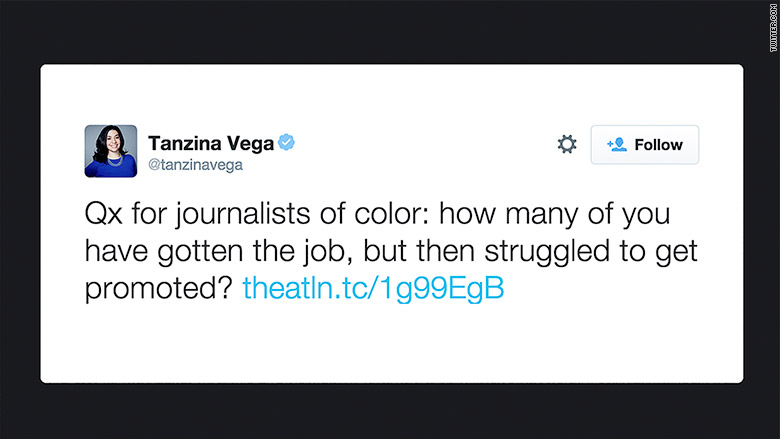
If you are a journalist of color, you've heard this one before. Despite the demographics of the United States rapidly shifting from a white majority to a brown and black one, why is there so little diversity in the news media?
The numbers released this week by the American Society of News Editors and the School of Journalism and Mass Communication at Florida International University paint a discouraging portrait of how little progress has been made in hiring minority journalists.
Of the 32,900 people employed in newspaper newsrooms around the country, only about 12.76%, or 4,200, are racial minorities. And that number has remained relatively steady for the past few years (11.85% in 2000, 13.73% in 2006 and 12.76% in 2014).
As a Latina who has covered race, ethnicity and the media business (sometimes all at once), I know what it's like to be one of a handful of women of color in a newsroom -- be it print, digital or television. So on Tuesday morning, I posed a series of questions about media diversity on my Twitter timeline.
By Wednesday afternoon -- more than 24 hours later -- we had started using the hashtag #MediaDiversity and the conversation was still going. Thousands of people had seen tweets about #MediaDiversity. Journalists of color had a lot to say about how they broke into the business, the support systems they've had, want or need and the socioeconomics of working in media.
I started out asking journalists of color ("JOC" in Twitter speak) what they covered and where they went to school but the conversations quickly turned to deeper issues like whether poor, working class journalists of color can actually afford to enter a business that often relies on unpaid internships and low paying assignments.
As someone who grew up in a working class community, I know firsthand how people struggle to decide their careers based on whether they will have the ability to afford to do them.
"If you can live off freelance gigs and pay for your own travel and wait for late checks to arrive, you have a HUGE leg up starting out," Tweeted the writer Jay Caspian Kang.
Amy S. Choi, the editorial director at Mash-Up Americans had this to say: "But I was privileged enough to take un or low paid internships and had no college debt when I graduated."
The conversation turned to how people were able to get their jobs. I, for example, mentioned traveling two and half hours each way from New Jersey to Long Island to work at a trade magazine when I started out. Trade magazines, ethnic media and smaller independent publications were where some journalists of color got their start:
Gautham Nagesh, a reporter covering the auto industry for the Wall Street Journal also started in the trades. Nagesh tweeted: "Trades are a lot closer to fair on hiring. I tend to think it's the best route for minorities w/o connections, but I'm biased."
But how much do mainstream media (or MSM in Twitter speak) hiring managers value that type of experience?
Rebecca Carroll, a writer who works on digital media for Scenarios USA weeted "Tried to hire an editor frm all-blk pub to MSM site - white supervisor response: "she'd be coming from nowhere"
OUCH.
Like many journalists, I worked nights, weekends and holidays and held down multiple internships (at WNYC Radio and Reuters Television), while also working as a news clerk and stringer at The New York Times. (That's where I met Gene Demby, who was also a clerk.) Demby is now the lead writer for the NPR race and culture blog "Code Switch" and a social media superstar unto himself.
Demby started a blog called PostBourgie while still at The Times, writing for it surreptitiously. He then moved on to work at The Huffington Post where diversity was lacking, except in the verticals that catered to people of color (POC in Twitter speak). Demby Tweeted:
"We used to jokingly call where @blackvoices and @LatinoVoices sat — we were all the POC in the newsroom, save one or 2 -- the 'South Bronx.'
But through the creation of the blog and his continued work in this space Demby was also successful in creating a solid network of peers, something many of the journalists in the conversation said was absolutely critical to surviving and moving up.
Demby tweeted: "we were squad, and we looked out for each other and when someone was in a position to accept pitches at their places we pitched to them."
Latoya Peterson, the deputy editor for Voices at Fusion tweeted: "Let me actually take a second to acknowledge some of these folks as well. Make friends, not professional contacts. Friends have your back."
Hiring managers were also on the hook during the conversation.
Madhulika Sikka, the executive editor of Mic tweeted: "To "Only one in room" add "One & Done" #mediadiversity if a POC fails at a job, looked upon as "oh we tried that" @tanzinavega @GeeDee215"
Justin Ellis, a writer who covers media for Nieman Lab added: "Think about that. Revenue diversification? Critical to survival. Newsroom diversification? Further down the list. #mediadiversity"
Steve Katz, the publisher of Mother Jones, called out hiring managers directly, tweeting: "Deep, important, real convo abt #mediadiversity w @GeeDee215 @LatoyaPeterson @tanzinavega. You hiring? Read this."
Perhaps most telling was the fact that out of all of the tweets, replies, retweets and hashtags, the most popular tweet I posted was one pointing to a web site meant to answer this question:
"We can't find qualified minorities." Yes you can. Here they are: diversify.journalismwith.me.
The tweet was seen by almost 34,000 people. That's a lot of eyeballs and maybe, just maybe, someone in human resources was paying attention.


